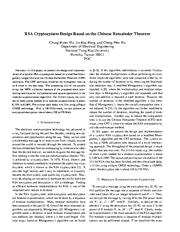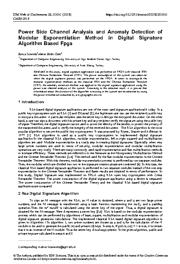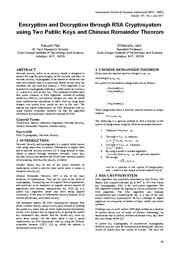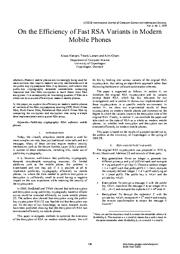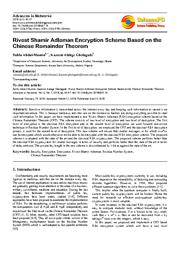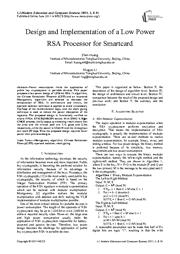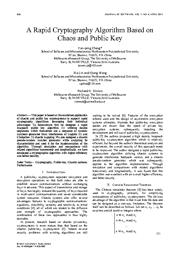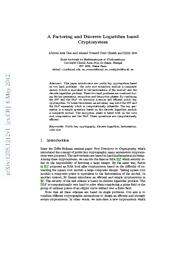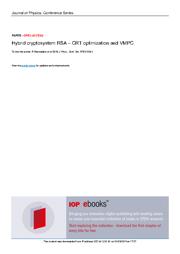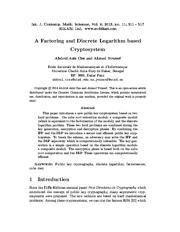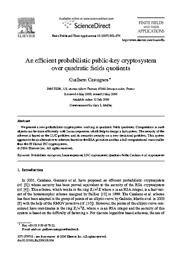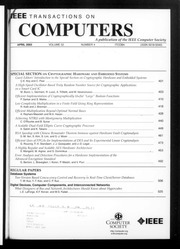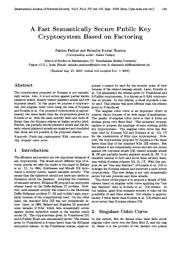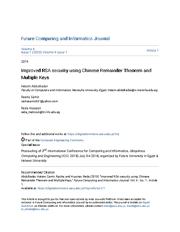A copy of this work was available on the public web and has been preserved in the Wayback Machine. The capture dates from 2017; you can also visit the original URL.
The file type is application/pdf.
Filters
RSA cryptosystem design based on the Chinese remainder theorem
2001
Proceedings of the 2001 conference on Asia South Pacific design automation - ASP-DAC '01
In this paper, we present the design and implementation of a systolic RSA cryptosystem based on a modified Montgomery's algorithm and the Chinese Remainder Theorem (CRT) technique. ...
The CRT technique improves the throughput rate up to 4 times in the best case. ...
RSA Computation Using CRT The Chinese Remainder Theorem (CRT) can be stated as follows. ...
doi:10.1145/370155.370419
dblp:conf/aspdac/WuHW01
fatcat:btnsbddvs5cyxow57a7veudxde
RSA cryptosystem design based on the Chinese remainder theorem
Proceedings of the ASP-DAC 2001. Asia and South Pacific Design Automation Conference 2001 (Cat. No.01EX455)
In this paper, we present the design and implementation of a systolic RSA cryptosystem based on a modified Montgomery's algorithm and the Chinese Remainder Theorem (CRT) technique. ...
The CRT technique improves the throughput rate up to 4 times in the best case. ...
RSA Computation Using CRT The Chinese Remainder Theorem (CRT) can be stated as follows. ...
doi:10.1109/aspdac.2001.913338
fatcat:c6vkoaj7qbgv3ftn3emlzroysa
Power Side Channel Analysis and Anomaly Detection of Modular Exponentiation Method in Digital Signature Algorithm Based Fpga
2018
ITM Web of Conferences
In this study, digital signature application was performed on FPGA with classical RSA and Chinese Remainder Theorem (CRT). ...
In order to distinguish the modular exponentiation methods as the classical RSA and the Chinese Remainder Theorem (CRT), the anomaly detection method was applied to the digital signature application using ...
The Chinese Remainder Theorem compares the power consumption of classical RSA based digital signatures. ...
doi:10.1051/itmconf/20182201041
fatcat:m76dzsfsmratbpapjhifjvtn5e
Encryption and Decryption through RSA Cryptosystem using Two Public Keys and Chinese Remainder Theorem
2017
International Journal of Computer Applications
And by using those integers two public keys would be sent to the user. The scheme has speed enhancement on RSA decryption side by using Chinese remainder theorem. ...
So that the algorithm overcomes several attacks which are possible on RSA. General Terms RSA(Rivest, Shamir, Adlemen) Algorithm, Network Security, Chinese Remainder Theorem, Number theory. ...
theory and Chinese remainder theorem and public key cryptosystem. ...
doi:10.5120/ijca2017914674
fatcat:alcmjnuwvnfjnmpqex7oepvlqu
On the Efficiency of Fast RSA Variants in Modern Mobile Phones
[article]
2010
arXiv
pre-print
In this paper, we explore the efficiency on modern mobile phones of variants of the RSA cryptosystem, covering CRT, MultiPrime RSA, MultiPower RSA, Rebalanced RSA and R Prime RSA by comparing the encryption ...
Modern mobile phones are increasingly being used for more services that require modern security mechanisms such as the public key cryptosystem RSA. ...
Then, using the Chinese Remainder Theorem, find M as M = (M p q(q -1 mod p) + M q p(p -1 mod q)) mod N. ...
arXiv:1001.2249v1
fatcat:mjkyqo55zjew5alkso6yigxrzm
Rivest Shamir Adleman Encryption Scheme Based on the Chinese Remainder Theorem
2018
Advances in Networks
In this paper, we have implemented a new Rivest Shamir Adleman (RSA) encryption scheme based on the Chinese Remainder Theorem (CRT). ...
The proposed scheme is evaluated with the state of the art and the classical RSA cryptosystem. ...
This means that more information can be represented in the proposed scheme than that in [20] .
Conclusion A new RSA cryptosystem have been implemented using Chinese Remainder Theorem. ...
doi:10.11648/j.net.20180601.14
fatcat:ku6ktyrmkvfkljj55sfvrzbeom
Design and Implementation of a Low Power RSA Processor for Smartcard
2011
International Journal of Modern Education and Computer Science
In algorithm, the Chinese Remainder Theorem (CRT) and an improved Montgomery algorithm are selected to decrease the computation of RSA. ...
Power consumption limits the application of public key cryptosystem in portable devices. This paper proposes a low power design of 1,024-bit RSA. ...
Layout of the smartcard with RSA processor APPENDIX A THE PROOF OF CHINESE REMAINDER THEOREM Two theorems will be used when performing RSA modular exponentiation. ...
doi:10.5815/ijmecs.2011.03.02
fatcat:o4ldvqumvbcw3iakxrpoby5wje
A Rapid Cryptography Algorithm Based on Chaos and Public Key
2012
Journal of Software
This paper is based on the combined application of chaotic and public key cryptosystems to support rapid cryptography algorithms, leveraging their individual advantages. ...
We also designed a chaotic pseudo-random number generator while analyzing its characteristics and used it for the implementation of the algorithm. ...
CHINESE REMAINDER THEOREM The Chinese remainder theorem [8] has been widely used in cryptography, primarily for simplifying computations of public-key cryptosystems. ...
doi:10.4304/jsw.7.4.856-860
fatcat:2xeaqc7vavgchctq43kedxzxce
A Factoring and Discrete Logarithm based Cryptosystem
[article]
2012
arXiv
pre-print
This paper introduces a new public key cryptosystem based on two hard problems : the cube root extraction modulo a composite moduli (which is equivalent to the factorisation of the moduli) and the discrete ...
The key generation is a simple operation based on the discrete logarithm modulo a composite moduli. The encryption phase is based both on the cube root computation and the DLP. ...
Using the Chinese Remainder Theorem, we recover the unique solution of the equation modulo n. ...
arXiv:1205.1212v2
fatcat:fyf2bopryrbvdfd54bfu6tsmna
Hybrid cryptosystem RSA – CRT optimization and VMPC
2018
Journal of Physics, Conference Series
The results show hybrid cryptosystem RSA -CRT optimization and VMPC is faster than hybrid cryptosystem RSA -VMPC and hybrid cryptosystem RSA -CRT -VMPC. ...
RSA -CRT optimization speeds up the decryption process by obtaining plaintext with dp and p key only, so there is no need to perform CRT processes. ...
In this modification, the decryption process is based on the CRT (Chinese Remainder Theorem) method and improvisation on the modulus multiplication. ...
doi:10.1088/1742-6596/978/1/012041
fatcat:wgyvgafgibhqhc3w2pe3tuk7fu
A factoring and discrete logarithm based cryptosystem
2013
International Journal of Contemporary Mathematical Sciences
This paper introduces a new public key cryptosystem based on two hard problems : the cube root extraction modulo a composite moduli (which is equivalent to the factorisation of the moduli) and the discrete ...
The key generation is a simple operation based on the discrete logarithm modulo a composite moduli. The encryption phase is based both on the cube root computation and the DLP. ...
Using the Chinese Remainder Theorem, we recover the unique solution of the equation modulo n. ...
doi:10.12988/ijcms.2013.13050
fatcat:tqofttt2dzc5rpab6ouvmo7cgy
An efficient probabilistic public-key cryptosystem over quadratic fields quotients
2007
Finite Fields and Their Applications
This system appears to be an alternative to schemes based on the RSA primitive and has a full computational cost smaller than the El Gamal EC cryptosystem. ...
The security of the scheme is based on the LUC problem and its semantic security on a new decisional problem. ...
We now describe the decryption algorithm using the Chinese Remainder Theorem. ...
doi:10.1016/j.ffa.2006.05.004
fatcat:5wweofxi2nhilg5qbebkyxuwlq
Page 472 of IEEE Transactions on Computers Vol. 52, Issue 4
[page]
2003
IEEE Transactions on Computers
Kocher
man, RSA Advances in Cryptology 1996 Robshaw, “Comments on Some New RSA Laboratories Bulletin, 5, July 1997 Schindler \
Theorem
no 24) W Remainder
Timing Attack against RSA with the Chinese Cryptographic ...
Quisquater, “Chinese Remainder- ing Based Cryptosystems in the Presence of Faults,” J]. Cryptology, 2, no. 4, pp. 241-245, 1999.
[14] M. Joye, F. Koeune, and J.-J. ...
A Fast Semantically Secure Public Key Cryptosystem Based on Factoring
2006
International Journal of Network Security
Our proposed cryptosystem is approximately two times faster than the cryptosystem given by Kouichi et al. with the same security label and more efficient than the Koyama scheme at higher security label ...
In this paper we propose a cryptosystem over singular cubic curve using the idea of Koyama and Kouichi et al. ...
This one way function was named after most significant bits zeroes function (M SBZ). The equivalence between RSA and G-RSA cryptosystem was based on the following theorems. ...
dblp:journals/ijnsec/PadhyeS06
fatcat:ufs5wdaf6jhjrg7bmj3blmrfb4
Improved RSA security using Chinese Remainder Theorem and Multiple Keys
2019
Future Computing and Informatics Journal
based on multi keys and Chinese remainder theorem (CRT), which RSA algorithm is asymmetric key encryption technique. ...
Which is the Network security is an activity which is designed to provide the usage protection and integrity of the Network and data. ...
Chinese Remainder Theorem rivest, Shamir, and ad leman discovered method to implement the cryptography public-key In 1978 [6] .which is known with the RSA cryptosystem. ...
doi:10.54623/fue.fcij.4.1.1
fatcat:qtdxhi77h5h3bb3smqy324puxy
« Previous
Showing results 1 — 15 out of 786 results

